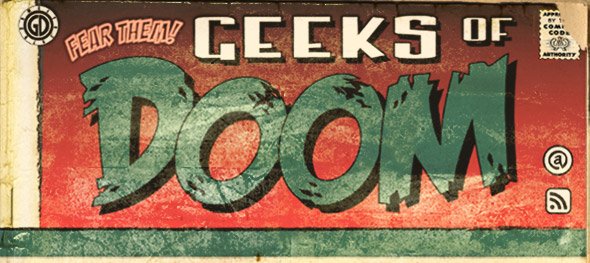 Gonzo: A Graphic Biography Of Hunter S. Thompson
Gonzo: A Graphic Biography Of Hunter S. Thompson
Written by Will Bingley
Illustrated by Anthony Hope-Smith
Page Layout and Lettering by Andy Huckle
Abrams Comic Arts
Release Date: April 2012
Cover Price: $17.95
Abrams Comic Arts has released Gonzo: A Graphic Biography of Hunter S. Thompson and that word “graphic” certainly takes on many different definitions here when applied to the protagonist of this true-life comic novel.
The public’s perception of the late writer/journalist/self-made psychopath (by his own volition) is as varied and misunderstood as the man himself. Some of us only know Hunter S. Thompson as a modern day mid/late 20th century figure whose thirst and unbridled lust for all things excess is regarded as the stuff of filthy, unrelenting legend. Some of us only know him as Uncle Duke, the famous cartoon character who shook up the long-running comic strip Doonesbury when he first appeared in the mid 1970s in that strip, a character that Thompson had gone on record as hating. Some of us know him as simply a film character, portrayed by Johnny Depp in director Terry Gilliam’s cult film adaptation of what seemed as unfilmable as William S. Burroughs’ Naked Lunch, Thompson’s arguably best known work, Fear and Loathing in Las Vegas. And there was also the recent attempt at a film adaptation of another Thompson work, last year’s box office mess, The Rum Diary, again with Depp as its star.
None of these portrayals still really got into the head of its central figure, a larger than life human being who pushed envelopes with steam rollers of his own making, who cheated, lied, drank, and drugged his way through the tepid and medium cool hybrids of journalism and prose and literature that was the norm of the 60s and 70s, save for a few renegade authors, Ken Kesey, Jack Kerouac, and Allen Ginsburg among a few more.
As an American, Thompson became at once an outlaw, a zealot of radical change, a harbinger of an unorthodox future of the country in which sacred cows and tight conservative values were to be assassinated by his own pen, which was indelibly dipped always in poison and always aimed directly at those he despised. No one escaped the wrath of his prose and text, especially if they were the ones who kept, as the expression goes, “the man down,” meaning keeping down all those who championed their own freedoms and values, personal goals with a “don’t give a flying fuck who cares attitude,” which were all components that were part of the steely machine framework that was Hunter S. Thompson.
There have been many attempts to put his wild, crazy, sprawling story into a concise biographical form since his suicide in 2005. Many of them have also just spoke of the man in clichés and obvious-isms, the fringe stuff about him that made one at once cringe, marvel, and ultimately feel sorry for the man who invented the term “Gonzo Journalism,” a reckless free-for-all style that peaked in the 1970s and is hardly used, let alone remembered today by most writers.
Now, Abrams Comics, has released their own take on the man, a graphic novel called Gonzo, which tries to encapsulate the man’s life in 180 pages, and done in stark, sleek, movie-style black and white illustrations. Writer Will Bingley eschews many standard generic “biographical” approaches and presents the man in a more surreal light, still telling his story (and bending the facts a bit) in a sure-footed manner. Illustrator Anthony Hope-Smith, uses his pen strokes here liberally and fluidly, and the two men have created a tome that is indeed worth a glance or two or three.
In breathless style, they make for an easy read that interchanges moods and feelings as we go through Thompson’s breakneck pace of a life quickly, as fast as the man himself. They start with Thompson’s beginnings as a juvenile delinquent growing up in Louisville to his colorful adventures which led him to become a key figure in the journalism industry, as we see his meteoric rise by way of penning stories for early issues of Rolling Stone magazine. He eventually became a key radical correspondent politically, and his attempts to shoot holes through the then Nixon administration, further cemented his notoriety and off-kilter legend. He also experienced plenty of partying and drugging in late 60s and early 70s, sporting a sort of rock star lifestyle along the way, which made him a hero to the standard norm crippled folks of society, but also ultimately alienated him from anyone close to him. The book mainly focuses on this era, by the late 70s to his suicide in 1995 (which is refreshingly only hinted at, and thankfully not shown) and the novel takes liberties in fast forwarding a lot of that late era of Thompson’s, when he arguably and unfortunately, lost his relevance in a world that changed its values as rapidly as he didn’t change ever change his.
When one is done with Gonzo, one really doesn’t know any more about Hunter S. Thompson than when they started. It’s not Bingley and Hope-Smith’s fault, the man was just too complex and over the top to be really restrained in any way, shape or form, a graphic novel notwithstanding. But, there is a nice way that Bingley and Hope-Smith create a kind of voyeuristic window here in which the reader can peer into a little diffused look at the man who may have his legacy firmly entrenched in his habitual lifestyle more than the work and literary art he pioneered to those that know about it. At its best, Gonzo is the closest attempt at trying to humanize a man who made his living trying to transcend what a human being can do with himself, in both his art and craft and his selfless and selfish self.






No Comments »
No comments yet.
RSS feed for comments on this post. TrackBack URL
Leave a comment